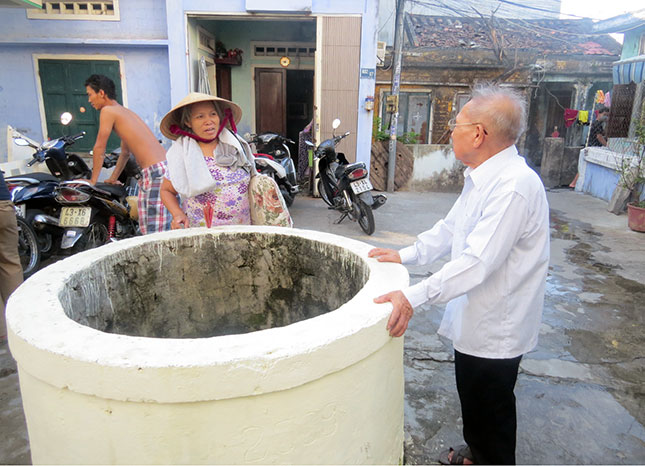Ancient wells feature time-honoured cultural values
To date, there have been no specific statistics on the number of ancient wells across Da Nang, and how valuable they are as well. However, according to local cultural researchers, ancient wells vividly reflect the long-lasting cultural and historical values that need to be preserved for future generations.
 |
| Villagers usually meet and friendly chat with one another near hundreds-year-old wells. An ancient well is seen in Son Tra District’s An Hai Bac Ward |
Mr Dang Dung, who is dubbed by the villagers as ‘the Nam O historian’ in Lien Chieu District’s Hoa Hiep Bac Ward, proundly said the time-honoured village is home to many mysterious square wells.
The old square wells are unique because of their shapes and mysterious tales told by locals.
Four of the original 6 wells are scattered throughout Nam O Village at distances ranging from 200m to 300m. The other two were victims of the National Highway 1A extension.
The wells are lined with rectangular stone slabs 1m x 0.6m and 10cm thick laid symmetrically. They always have particularly fresh and sweet water even in the dry season.
According to senior citizens living in the village, the 4 wells left today in the village were made from a type of special rocks sourced from the former Truong Dinh area, now located in Hoa Vang District’s Hoa Lien Commune, about 7km to the west of the Nam O Village.
Since 1997, the Lien Chieu District Culture and Information Office has cooperated with the Da Nang Museum and the Ho Chi Minh City-based Archaeological Institute to conduct their research activities into the wells.
As yet, they have yet to identify exactly who built them. However, initial research results show that they may have been built by the Cham people. Most of the senior villagers believe this is so.
Meanwhile, some inhabitants hold the belief that these well were built in 17th century and onwards.
Many senior citizens always ponder on how to preserve and honour the great values of the historical and cultural sites in the current context of the city’s rapid urbanization.
The hundreds-year-old mysterious square wells in the Nam O Village are considered as the precious cultural relics that the ancestors passed down.
In addition, according to the ancient spiritual concept associated with Feng shui, wells highlight the classical elements of earth, water, and air which play a vital role in the living space of the predecessors.
Folklorist Vo Van Hoe, the Chairman of the Folk Arts Association, said he once saw similar square wells in Cam Le District’s Khue Trung Ward, Hai Chau District’s Binh Hien Ward, and near the former intersection of Phan Thanh and Nguyen Van Linh streets.
Mr Nguyen Ngoc Nghi from the management board of the Thac Gian Village Communal House revealed that there was a nearly 200-year-old well made from laterite rocks which was built in the 17th century during the feudal Le Dynasty.
In the past, at Tet, senior citizens in the ancient villages were the first to take sacred water from holy wells to prepare meals offered to the ancestors.
Experiencing the vicissitudes of the history, especially under the impacts of the urbanisation, some time-honoured villages still keep intact the unique characteristics of Vietnamese rural villages.
Such interesting features include communal houses, old wells, winding pathways, banyan trees, temples, and multi-hundred-year-old houses.
In particular, ancient wells vividly reflect the spiritual lives of the inhabitants. It is high time, therefore, to develop plans for preserving and uphold the great historical and cultural values of these special wells.